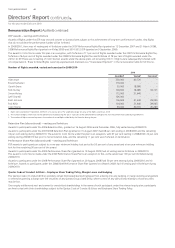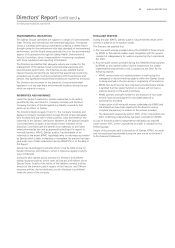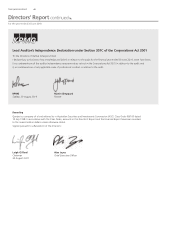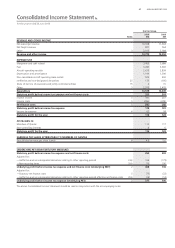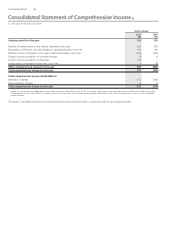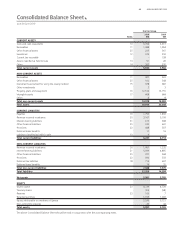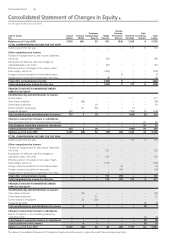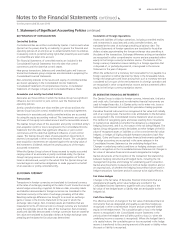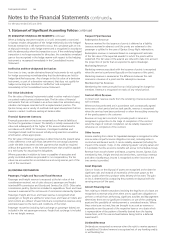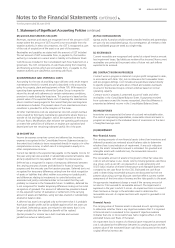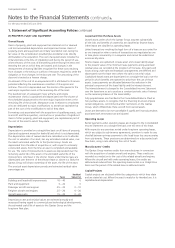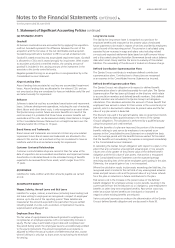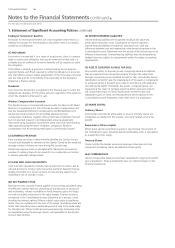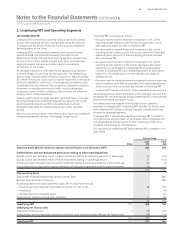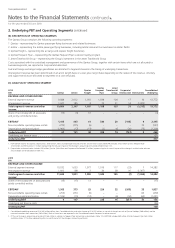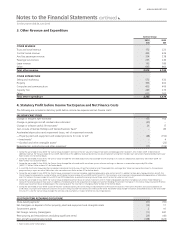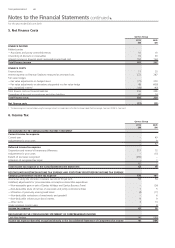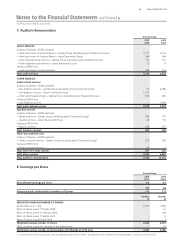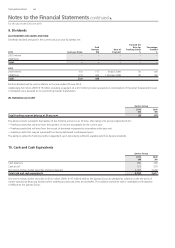Qantas 2010 Annual Report Download - page 56
Download and view the complete annual report
Please find page 56 of the 2010 Qantas annual report below. You can navigate through the pages in the report by either clicking on the pages listed below, or by using the keyword search tool below to find specific information within the annual report.
THE QANTAS GROUP 54
for the year ended 30 June 2010
Notes to the Financial Statements continued
When a hedging instrument expires or is sold, terminated or exercised,
or Qantas revokes designation of the hedge relationship but the hedged
forecast transaction is still expected to occur, the cumulative gain or loss
at that point remains in the hedge reserve and is recognised in accordance
with the above policy when the transaction occurs. If the underlying hedged
transaction is no longer expected to take place, the cumulative unrealised
gain or loss recognised in the hedge reserve with respect to the hedging
instrument is recognised immediately in the Consolidated Income
Statement.
Ineffective and Non-designated Derivatives
From time to time, certain derivative nancial instruments do not qualify
for hedge accounting notwithstanding that the derivatives are held to
hedge identi ed exposures. Any changes in the fair value of a derivative
instrument, or part of a derivative instrument, that does not qualify for
hedge accounting are classi ed as ‘ineffective’ and recognised
immediately in the Consolidated Income Statement.
Fair Value Calculations
The fair value of nancial instruments traded in active markets is based
on quoted market prices at balance date. The fair value of nancial
instruments that are not traded in an active market are estimated using
valuation techniques consistent with accepted market practice. The
Qantas Group uses a variety of methods and input assumptions that are
based on market conditions existing at balance date.
Financial Guarantee Contracts
Financial guarantee contracts are recognised as a nancial liability at
the time the guarantee is issued. The liability is initially measured at fair
value and subsequently at the higher of the amount determined in
accordance with AASB 137 Provisions, Contingent Liabilities and
Contingent Assets and the amount initially recognised less cumulative
amortisation, where appropriate.
The fair value of nancial guarantees is determined as the present value
of the difference in net cash ows between the contractual payments
under the debt instrument and the payments that would be required
without the guarantee, or the estimated amount that would be payable
to a third party for assuming the obligations.
Where guarantees in relation to loans or payables of associates and
jointly controlled entities are provided for no compensation, the fair
values are accounted for as contributions and recognised as part of the
cost of the investment.
(G) REVENUE RECOGNITION
Passenger, Freight and Tours and Travel Revenue
Passenger and freight revenue is measured at the fair value of the
consideration received, net of sales discount, passenger and freight
interline/IATA commission and Goods and Services Tax (GST). Other sales
commissions paid by Qantas are included in expenditure. Tours and travel
revenue is measured at the net amount of commission retained by Qantas.
Passenger, freight and tours and travel revenue is recognised when
passengers or freight are uplifted or when tours and travel air tickets and
land content are utilised. Unused tickets are recognised as revenue using
estimates based on the terms and conditions of the ticket.
Passenger recoveries (including fuel surcharge on passenger tickets) are
included in the net passenger revenue. Freight fuel surcharge is included
in the net freight revenue.
Frequent Flyer Revenue
Redemption Revenue
Revenue received for the issuance of points is deferred as a liability
(revenue received in advance) until the points are redeemed or the
passenger is uplifted in the case of Qantas Group ight redemptions.
Redemption revenue is measured based on management’s estimate
of the fair value of the expected awards for which the points will be
redeemed. The fair value of the awards are reduced to take into account
the proportion of points that are expected to expire (breakage).
Marketing Revenue
Marketing revenue associated with the issuance of points is recognised
when the service is performed (typically on the issuance of the point).
Marketing revenue is measured as the difference between the cash
received on issuance of a point and the redemption revenue.
Membership Fee Revenue
Membership fee revenue results from an initial joining fee charged to
members. Revenue is recognised on expiry of any refund period.
Contract Work Revenue
Contract work revenue results from the rendering of services associated
with contracts.
Where services performed are in accordance with contractually agreed
terms over a short period and are task speci c, revenue is recognised
when the services have been performed or when the resulting ownership
of the goods passes to the customer.
Revenue on long-term contracts to provide goods or services is
recognised in proportion to the stage of completion of the contract
when the stage of contract completion can be reliably measured or
otherwise on completion of the contract.
Other Income
Income resulting from claims for liquidated damages is recognised as other
income when all performance obligations are met, including when a
contractual entitlement exists, it can be reliably measured (including the
impact of the receipt, if any, on the underlying assets’ carrying value) and
it is probable that the economic bene ts will accrue to the Qantas Group.
Revenue from aircraft charter and leases, property income, Qantas Club
membership fees, freight terminal and service fees, commission revenue
and other miscellaneous income is recognised as other income at the
time service is provided.
Asset Disposals
Gains or losses on the disposal of assets are recognised at the date the
signi cant risks and rewards of ownership of the asset passes to the
buyer, usually when the purchaser takes delivery of the asset. The gain
or loss is determined by comparing the proceeds on disposal with the
carrying amount of the asset.
Aircraft Financing Fees
Fees relating to linked transactions involving the legal form of a lease are
recognised as revenue only when there are no signi cant obligations to
perform or refrain from performing, signi cant activities and Management
determines there are no signi cant limitations on use of the underlying
asset and the possibility of reimbursement is considered remote. Where
these criteria are not met, fees are brought to account as revenue or
expenditure over the period of the respective lease or on a basis which
is representative of the pattern of bene ts derived from the leasing
transactions, with the unamortised balance being held as a deferred
lease bene t.
Dividend Revenue
Dividends are recognised as revenue when the right to receive payment
is established. Dividend revenue is recognised net of any franking credits
or withholding tax.
1. Statement of Signi cant Accounting Policies continued
(F) DERIVATIVE FINANCIAL INSTRUMENTS continued


